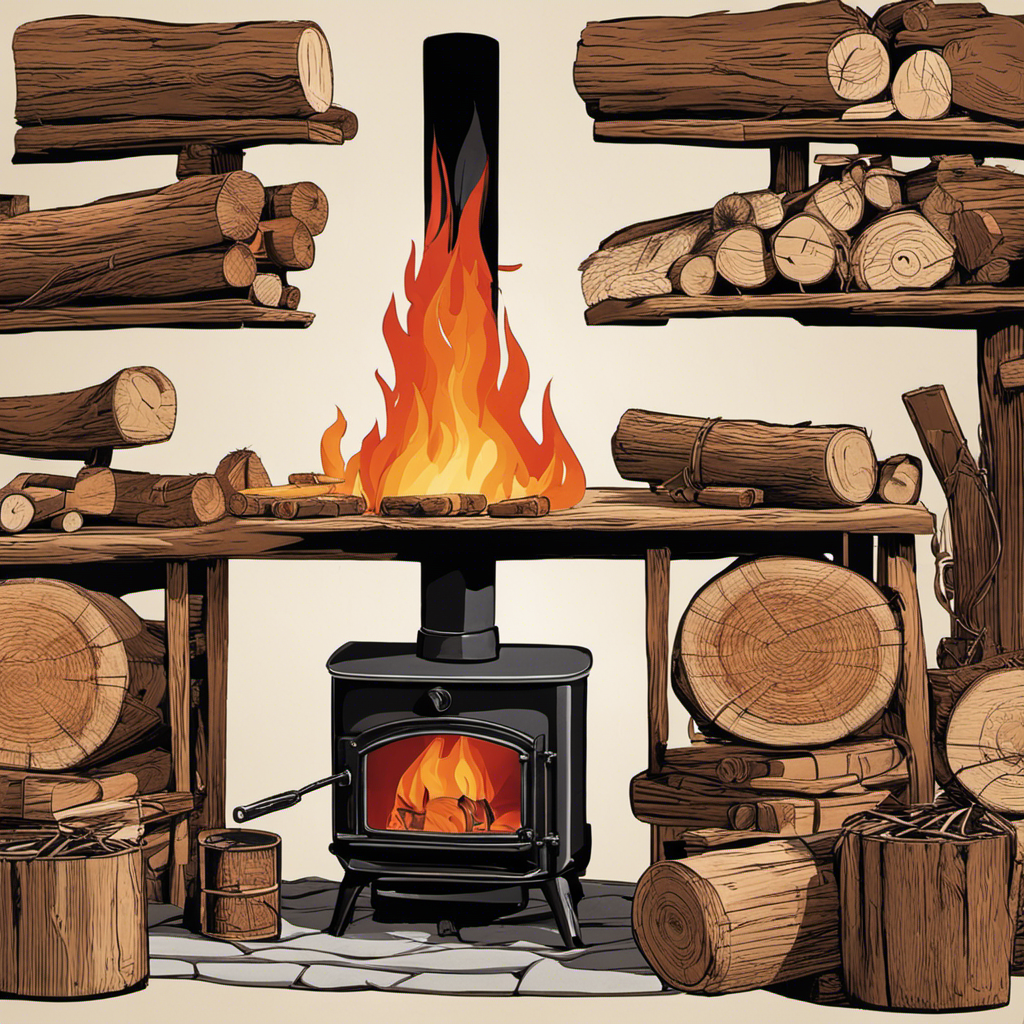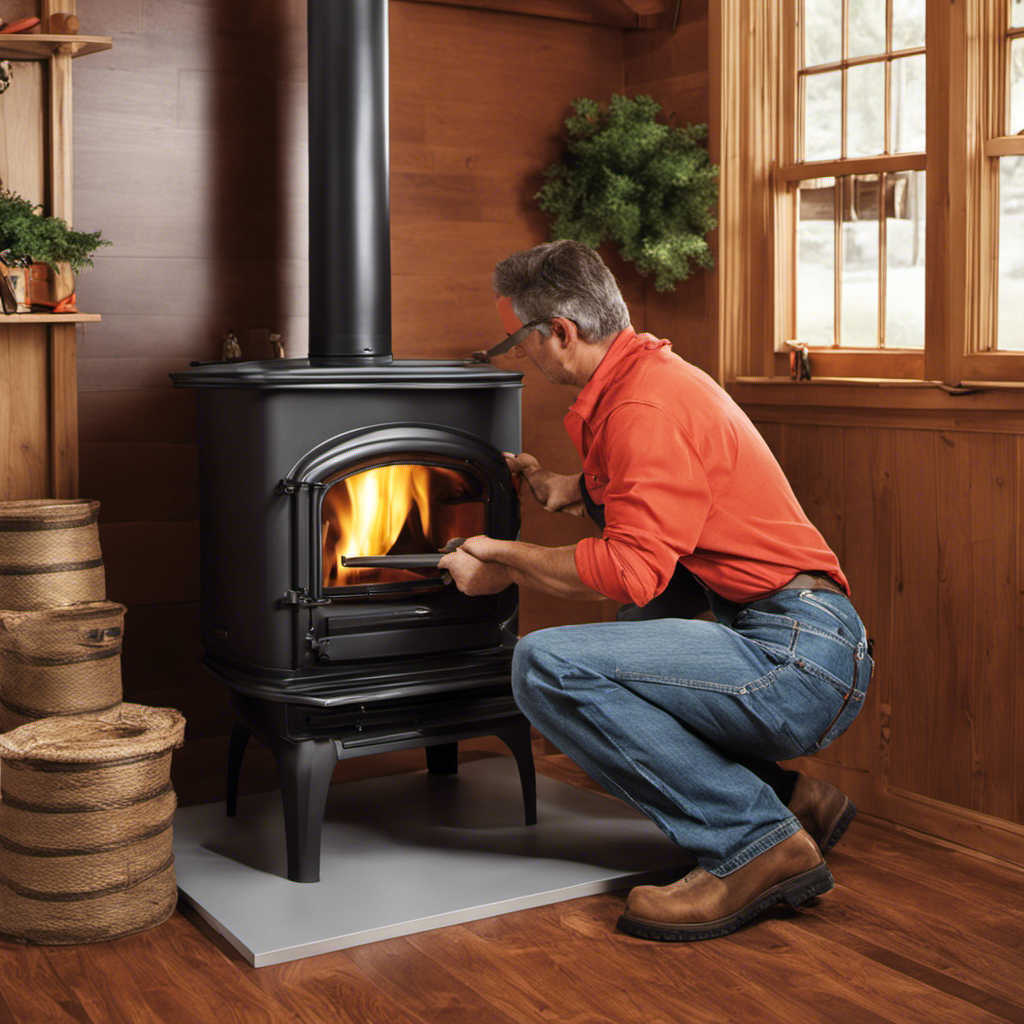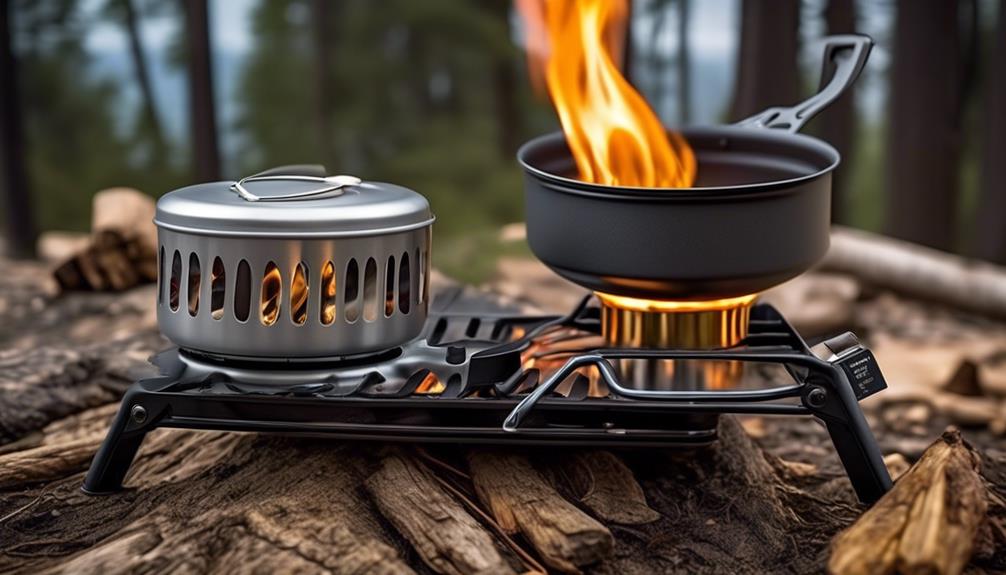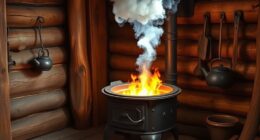Sitting beside my wood stove invariably brings me a sense of warmth and tranquility. I am always amazed at its ability to calm and console me.
Building a fire in a wood stove is a skill that every homeowner should possess. In this article, I will guide you through the process step by step, from choosing the right wood to maintaining the fire.
By the end, you’ll be able to enjoy the soothing crackle and radiant heat of a perfectly built fire in your own wood stove.
Key Takeaways
- Properly seasoned wood is essential for efficient and smoke-free burning.
- Hardwoods like oak, maple, and birch are ideal for wood stoves, while softwoods like pine and spruce are used for starting the fire.
- Arranging and sizing the firewood correctly promotes airflow and ventilation, maximizing heat output and reducing creosote buildup.
- Ensuring proper airflow and ventilation, using a stove fan, and regular maintenance are crucial for efficient combustion and chimney safety.
Choosing the Right Wood
I always make sure to choose the right wood for my wood stove. When it comes to building a fire, the type of wood you use plays a crucial role in its success. One important factor to consider is whether the wood has been properly seasoned. Seasoning wood involves allowing it to dry out for a period of time, typically six months to a year. This process removes excess moisture, making the wood burn more efficiently and produce less smoke.
There are different types of firewood to choose from, each with its own characteristics. Hardwoods, such as oak, maple, and birch, are ideal for wood stoves. They burn longer and produce more heat compared to softwoods like pine and spruce. Softwoods, however, ignite more quickly and are often used to get the fire started. It’s important to note that using green or unseasoned wood can lead to a less efficient fire, as it contains higher moisture content and may produce excess smoke.
Preparing the Firebox
To get started, I’ll need to make sure the firebox is clean and free of any debris. This is an important step to ensure a safe and efficient fire. Here’s what I do to prepare the firebox:
-
Cleaning the firebox: Before starting a fire, I always remove any ashes or leftover wood from the previous burn. Using a small shovel or brush, I carefully scoop out the ashes and dispose of them in a metal container. This not only improves the airflow but also prevents any potential fire hazards.
-
Insulating the firebox: Insulating the firebox is crucial for maintaining a high temperature and maximizing heat output. I use firebricks or refractory cement to line the walls of the firebox. This helps to retain heat and protect the stove from damage caused by high temperatures. Additionally, it ensures a more efficient burn by reflecting the heat back into the firebox.
-
Clearing the air vents: It’s essential to check and clean the air vents regularly. I ensure that the air vents are clear of any obstructions, such as ash or debris, that could prevent proper airflow. This allows for better combustion and helps maintain a steady and controlled fire.
Arranging the Firewood
When it comes to arranging the firewood, it’s important to consider the size of the logs. I always make sure to use logs that are about 3 inches in diameter, as they burn more efficiently.
Proper stacking technique is also crucial to ensure a steady supply of oxygen for a good burn.
Lastly, I always make sure to leave enough space between the logs to promote airflow and ventilation, which helps the fire to burn more consistently.
Size of Firewood
The smaller the firewood, the easier it’s to ignite in a wood stove. Splitting logs into smaller pieces not only makes them easier to handle, but also increases their surface area, allowing for faster and more efficient combustion. When it comes to drying firewood, smaller pieces dry faster than larger ones, reducing the moisture content and ensuring a cleaner burn.
Here are three reasons why using smaller firewood is beneficial:
-
Ignition: Smaller firewood catches fire quickly due to its increased surface area, making it easier to start a fire in the wood stove.
-
Faster Drying: Smaller logs dry faster than larger ones, meaning you can have dry firewood ready to use in a shorter amount of time.
-
Better Combustion: Smaller firewood burns more efficiently, producing less smoke and creosote buildup in the chimney.
Proper Stacking Technique
I find that using a proper stacking technique for firewood ensures stability and maximizes space efficiency in my storage area.
When it comes to firewood storage, organization is key. I start by clearing any debris or leaves from the area where the firewood will be stored.
Then, I stack the firewood in a neat and orderly manner. I make sure to place the larger pieces at the bottom and stack them in a crisscross pattern to create a stable base.
As I stack the wood, I also ensure that there’s enough space between each piece for air circulation. This is important for drying out the wood and preventing mold or rot.
Airflow and Ventilation
To ensure optimal drying and prevent moisture buildup, I always make sure there’s enough space between each piece of firewood for proper airflow and ventilation. This is crucial for maintaining a good fire and ensuring efficient burning. Here are three reasons why airflow and ventilation are important:
-
Preventing smoke buildup: When there’s proper airflow, smoke can easily escape through the chimney, preventing it from filling up the room and causing discomfort.
-
Enhancing combustion: Sufficient airflow allows the fire to burn more efficiently, producing more heat and consuming less fuel. This means you can stay warm while saving on firewood.
-
Reducing creosote buildup: Adequate ventilation helps in preventing the buildup of creosote, a highly flammable substance that can accumulate in the chimney. Regular chimney maintenance is essential to remove this buildup and prevent chimney fires.
In addition to ensuring proper airflow, using a stove fan can further enhance the efficiency of your wood stove. A stove fan helps circulate warm air throughout the room, ensuring even heat distribution and reducing the need to constantly adjust the fire. This can lead to greater comfort and energy savings.
Overall, maintaining good airflow and ventilation in your wood stove is crucial for a safe, efficient, and enjoyable fire. Regular chimney maintenance and the use of a stove fan can further optimize your wood stove experience.
Igniting the Fire
Now that the firewood is arranged, it’s time to ignite the fire and bring warmth to the room.
There are several effective methods for starting a fire, and it’s important to avoid common ignition mistakes.
In the following points, I’ll discuss the best fire-starting methods and provide guidance on how to avoid common pitfalls.
Best Fire-Starting Methods
My go-to method for starting a fire in a wood stove is using crumpled newspaper and small kindling. However, there are alternative fire starting materials that can be just as effective. Here are three options to consider:
-
Fire starters: These are small blocks or sticks made from compressed sawdust and wax. They ignite quickly and provide a steady flame to get your fire going.
-
Fatwood: This is resin-rich wood that can be found in the stumps or roots of pine trees. It ignites easily and burns hot, making it a great fire starter.
-
Dryer lint and wax: Save your dryer lint and dip it in melted candle wax. This creates a flammable ball that can be used to ignite your fire. It’s a cheap and easy alternative.
If you’re still having trouble starting your fire, there are a few troubleshooting tips to consider. Make sure your wood is dry and properly seasoned. Check the airflow in your wood stove and ensure that the damper is open. Finally, double-check that your firewood is stacked properly to allow for proper oxygen flow.
Common Ignition Mistakes
When starting a fire, it’s important to avoid common ignition mistakes like using damp kindling or not providing enough airflow. Ignition techniques play a crucial role in ensuring a successful fire in a wood stove.
One common mistake is using damp kindling, which can make it difficult for the fire to catch and spread. It’s important to make sure that the kindling is dry and properly seasoned.
Another mistake isn’t providing enough airflow. Without sufficient oxygen, the fire will struggle to ignite and stay lit. To troubleshoot this issue, try opening the stove’s damper or adjusting the air vents to increase the airflow.
Maintaining the Fire
I always make sure to add more firewood to the stove to maintain a steady and warm fire. Here are three important things to keep in mind when it comes to maintaining the fire in a wood stove:
-
Firewood Storage: It’s crucial to store firewood properly to ensure it burns efficiently and doesn’t introduce pests or moisture into your home. I recommend stacking firewood in a well-ventilated area, away from the house, and off the ground. This helps to prevent rot and allows air to circulate, drying the wood faster. Additionally, keeping the firewood covered with a tarp or a firewood rack will protect it from rain and snow.
-
Cleaning the Firebox: Regularly cleaning the firebox is essential for the efficient functioning of your wood stove. After each fire, remove the ashes and debris using a fireplace shovel or a specialized ash vacuum. Make sure to wear gloves and a dust mask for safety. A clean firebox allows for better airflow and prevents the build-up of soot and creosote, which can be a fire hazard.
-
Maintaining Airflow: Proper airflow is crucial for a steady and efficient fire. Make sure the air vents on your wood stove are open to allow oxygen to fuel the fire. However, it’s important to find the right balance and avoid burning the fire too hot, as this can cause damage to your stove or chimney. Experiment with adjusting the air vents until you find the optimal setting that maintains a steady burn without excessive smoke or heat loss.
Safety Tips and Precautions
Now that you know how to build a fire in a wood stove and maintain it properly, it’s important to discuss safety tips and precautions to ensure you’ve a safe and enjoyable experience.
First and foremost, it’s crucial to have a fire extinguisher nearby. In case of an emergency, such as a sudden flare-up or if the fire spreads beyond the stove, a fire extinguisher can quickly suppress the flames and prevent further damage. Make sure to have it easily accessible and that you know how to use it properly.
Additionally, it’s essential to install a carbon monoxide detector in the area where the wood stove is located. Carbon monoxide is a colorless and odorless gas that can be released during combustion and is extremely dangerous. A detector will alert you if there’s a buildup of carbon monoxide, allowing you to evacuate and seek help immediately.
Remember to regularly check and replace the batteries in both the fire extinguisher and carbon monoxide detector to ensure they’re functioning properly. These simple safety precautions can go a long way in protecting you and your loved ones.
Stay safe and enjoy the warmth and comfort of your wood stove responsibly.
Frequently Asked Questions
How Often Should I Clean My Wood Stove?
Cleaning frequency for a wood stove depends on usage and type of fuel. As a general rule, I clean mine at least once a month during the winter season. Regular maintenance is key to ensure optimal performance.
Here are some tips:
- Remove ashes regularly
- Clean the glass door
- Inspect and clean the chimney annually
- Check for any signs of damage or wear
Can I Use Treated or Painted Wood in My Wood Stove?
Using treated or painted wood in a wood stove isn’t recommended. Treated wood contains chemicals that can release toxic fumes when burned, posing health risks.
Painted wood also releases harmful chemicals when heated, which can be dangerous to breathe in.
It’s important to use only dry, seasoned firewood that’s free from any treatments or coatings to ensure a safe and efficient fire in your wood stove.
Is It Safe to Leave the Fire Unattended?
Leaving a fire unattended can pose potential dangers. It’s important to always prioritize safety when using a wood stove. If the fire is left unattended, there’s a risk of it spreading and causing a fire hazard.
It’s recommended to never leave a fire burning without supervision. Make sure to properly extinguish the fire before leaving the room or going to bed to avoid any accidents or damage.
What Should I Do if the Smoke Starts Coming Back Into the Room?
If smoke starts coming back into the room while I’ve a fire in my wood stove, there are a few things I can do to troubleshoot the issue and prevent smoke backflow.
First, I should check if the damper is fully open to allow proper airflow.
If it is, I can try adjusting the air intake to increase the draft.
Additionally, making sure the wood is dry and properly seasoned can also help prevent smoke from entering the room.
How Do I Know if My Wood Stove Is Properly Ventilated?
To determine if my wood stove is properly ventilated, I look for signs of poor ventilation. These can include smoke or odors lingering in the room, difficulty in getting the fire started, or a lack of heat being produced.
To improve ventilation, I make sure the air intake vents are clear of any obstructions, open the damper fully, and ensure there’s enough airflow around the stove.
Regularly cleaning and maintaining the stove also helps to ensure proper ventilation.
Conclusion
Building a fire in a wood stove isn’t just a practical task, it’s an art that connects us to our primal instincts. As the flames dance and the warmth envelops us, we’re reminded of the power and beauty of nature.
Just like tending a fire, we must nurture our own passions and desires, carefully fueling them to create a lasting impact in our lives.
So next time you build a fire, remember that it’s more than just heat—it’s a reflection of your inner fire.
Logan’s affair with adventure began in childhood. He hailed from a small town where vast forests bordered one side and endless shores stretched on the other. His days were spent exploring uncharted woods, climbing tall trees, or listening to the tales of old sailors. This early immersion in a world brimming with stories and mysteries became the foundation of his passion for writing.











